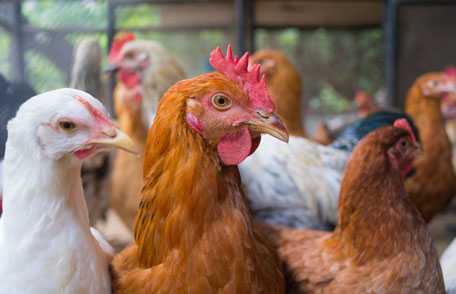Live Animal and Live Bird Markets
 We have many choices for buying and preparing our food today. Follow these steps when shopping for, handling, and preparing your food from live animal and live bird markets.
We have many choices for buying and preparing our food today. Follow these steps when shopping for, handling, and preparing your food from live animal and live bird markets.
Live animal and live bird markets are places where customers can buy an animal or bird to be slaughtered for food to take home. They are found in many cities and communities around the United States, serving customers with diverse ethnic, religious, and cultural backgrounds.
Salmonella and Raw Meat and Poultry
Live animals, such as cattle, sheep, goats, and swine, and live poultry, such as chickens, ducks, and geese, can carry Salmonella and other germs on the inside and outside of their bodies, even when they appear healthy and clean. Salmonella germs are shed in animal feces (poop) and can contaminate their bodies, including fur, skin, and feathers. These germs can get on raw meat or raw poultry from these animals during slaughter and processing.
Several foodborne illness outbreaks caused by Salmonella germs have been linked to meat or poultry purchased from live animal and live bird markets. More than half of the people who got sick in these outbreaks were children aged 5 years or younger.
In the outbreaks, people may have gotten sick in different ways:
- Picking up germs in market environments
- Eating improperly cooked meat or poultry from markets
- Improperly handling raw meat and poultry at home and cross-contaminating areas at home

Learn how to handle and prepare food purchased from live animal and live bird markets.
Follow these steps when shopping for, handling, and preparing your food:
At the Market
-
Clean
- Wash your hands with soap and water right after visiting areas where live animals and birds are kept.
- Even healthy-looking animals and birds can carry germs on their body and can spread them to their environment
-
Separate
- Do not enter animal or bird areas and do not perform the slaughter and processing if:
- You have a weakened immune system
- You are pregnant
- You have children ages 5 years or younger with you
- Do not eat or drink in areas where live animals and live birds are kept
- Do not carry carcasses or raw meat or poultry in the same container as other food items
- Wash reusable grocery bags
- Do not enter animal or bird areas and do not perform the slaughter and processing if:
-
Chill
- Refrigerate raw meat and poultry within 2 hours of purchase or sooner.
- Carry food in clean containers that can keep the contents cold, such as a plastic cooler or insulated bag.
- Keep raw meat and poultry carcasses or parts cold during transportation
At Home
-
Clean
- Wash your hands with soap and water before and after contact with raw meat and raw poultry.
- This is especially important before touching your own food, preparing baby bottles, or taking care of babies or children.
- Wash utensils, counters, and cutting boards with hot, soapy water before and after contact with raw meat and raw poultry.
- Clean and sanitize coolers or bags that held carcasses, raw meat or poultry, and other parts. Click here to learn how to properly sanitize.
- Wash your hands with soap and water before and after contact with raw meat and raw poultry.
-
Separate
- Cut-up or otherwise handle meat and bird carcasses in an area separate from areas where other foods are prepared.
- Keep raw meat and raw poultry away from fruits and vegetables and other foods that are ready-to-eat.
- Washing raw poultry before cooking it is not recommended. Bacteria in raw poultry juices can be spread to other foods, utensils, and surfaces.
-
Cook
- Use a food thermometer to make sure that meat and poultry are cooked to safe temperatures.
- Raw beef, pork, lamb and veal steaks, chops, and roasts: Needs to be cooked to an internal temperature of 145 °F (62.8 °C).
- Ground meats (raw ground beef, pork, lamb, and veal): Cook to an internal temperature of 160 °F (71.1 °C).
- Poultry and ground poultry: Needs to be cooked to an internal temperature of 165 °F (73.9 °C).
- For safety and quality, it is important to allow meat to rest for at least three minutes before carving or consuming.
- Use a food thermometer to make sure that meat and poultry are cooked to safe temperatures.
-
Chill
- Keep raw meat and poultry at 40°F or below until you are ready to cook it.
- Refrigerate cooked meat and poultry within 2 hours (or within 1 hour if the temperature is 90°F or higher).
- Freeze raw meat and poultry if you do not cook it within 2 days of purchase.
What is being done to help prevent illnesses?
Several local and state public health and animal health departments are jointly educating consumers at live animal and live bird markets, including:
- Displaying posters and handing out flyers and magnets with safe food handling messages in multiple languages
- Collaborating with local community groups
- Educating market owners and employees
- Inspecting markets with newly established inspection guidelines
Live animal and live bird markets must meet U.S. Department of Agriculture, Food Safety and Inspection Service (FSIS) sanitation requirements and prevent product adulteration. Regulatory oversight by state agencies varies.
More Information
More Information
Information for Consumers
- Reusable Grocery Bags Safety
- Fight BAC Partnership for Food Safety Education
- USDA-FSIS Kitchen Companion: Your Safe Food Handbook
- Is It Done Yet? USDA Safe Cooking Temperature Information
- USDA Meat and Poultry Hotline
- Ask Karen, Virtual Food Safety Representative
- CDC Gastrointestinal (GI) Diseases from Animals website
- CDC Foodborne Outbreaks website
Information for Public Health Professionals
- Emerging Infectious Diseases Journal: Human Salmonellosis and Live-Bird and Animal-Slaughter Markets, United States, 2007-2012
- Minnesota Department of Health: “Salmonellosis Associated with Exposure to Live Animal Slaughter Markets” presented at 8th Annual OutbreakNet meeting [247 KB]
- Minnesota Department of Health: Healthy Markets
- New York City Department of Health and Mental Hygiene: Food Safety
- Boston Public Health Commission: Boston Community Based Food Safety Campaign
- USDA FSIS: Federal Meat Inspection Act. Section 623 – Exemptions from inspection requirements
- USDA FSIS: Poultry Products Inspection Act
- USDA FSIS: Pathogen Reduction; Hazard Analysis and Critical Control Point (HACCP) Systems [1.4 MB]
- CDC Gastrointestinal (GI) Diseases from Animals website
- CDC Foodborne Outbreaks website
- Page last reviewed: May 16, 2016
- Page last updated: May 16, 2016
- Content source:
- National Center for Emerging and Zoonotic Infectious Diseases
- Page maintained by: Office of the Associate Director for Communication, Digital Media Branch, Division of Public Affairs




 ShareCompartir
ShareCompartir